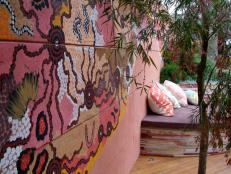How To Make Your Yard Private

"When in a garden or on a patio, you want to feel that you're in an intimate space — in a room not exposed as if you're in the middle of the driveway or street," says Risa Edelstein, president of the Ecological Landscaping Association.
That's not so easy when your back yard looks out on your neighbor's hot tub, your tranquility is constantly interrupted by road noise or your house sits in a new development with scant tree canopy. Here are some strategies for creating more privacy:
Fences. Privacy settings for fences range from private (solid tongue-and-groove or board) to semi-private (slat, picket, spindle or lattice) to rather public (rail). A topper made of lattice or circle cut-outs makes a solid fence feel less oppressive.
When considering materials, keep in mind the maintenance involved. Wood typically needs to be resealed, stained or painted every few years. Low maintenance options include powder-coated aluminum, vinyl and composite, all available in neutral shades of white, brown, black and green. Check local zoning regulations to ensure you have proper permits and do not exceed height restrictions, which are often lower for parts of the yard visible from the street.
Landscaping Privacy Solutions
See All PhotosWalls. Solid walls surrounding a courtyard provide the most privacy and can look attractive in fieldstone or cut stone, brick, adobe or concrete block. To make the space feel open and airy, provide site lines within the interior or through "windows" — a gate, arbor or scalloped section — that connects to other spaces. Soften the edges with plants that creep up a trellis or cascade over the edge. A structure such as a wooden pergola or arbor also provides contrasting texture that warms up the hardscape.
Evergreen Hedges. Living fences made of densely planted evergreens, especially columnar and upright conifers, offer privacy and tranquility by screening out busy street noises, reducing glare from headlights and acting as a wind break. While suitable for formal gardens, manicured privet hedges require frequent clipping. For a more natural looking barrier that's low-maintenance, use shrubs planted close together as more of a screen than a hedge.
Mixed Screen Plantings. Creating privacy in a heavily shaded yard can be challenging, says Robert Schucker, president of R&S Landscaping in Midland Park, N.J. One solution is a mixture of evergreens and deciduous trees, with an under story of flowering and evergreen shrubs. This allows light to penetrate during the winter and creates visual interest year-round.
Lattice. Lattice screens are a versatile and easy-to-install building element. They can be employed as semi-private walls on a deck or patio — or as the underpinning for a porch or deck. You can use lattice to corral an HVAC unit or garbage cans. Available in various weaves and grid patterns, lattice partners well with a range of materials and textures including stone, brick and board fence. Flowering shrubs, roses and vines add more privacy as the lattice becomes a textured back drop.
Treillage. Metal trellis-like panels mounted on a wood or steel frame can be used in lieu of or in addition to conventional fences and walls to provide a vibrant privacy screen. Placed on the side of a home, driveway or patio, these structures reduce ambient air temperatures by up to 10 degrees, according to the American Society of Landscape Architects. The usual rules of climate zone, sun and wind exposure, and soil type apply for choosing plant materials.
Vertical Gardens. Trevor Smith, vice president of the Ecological Landscaping Association and president of Land Escapes in Arlington, Mass., says that vertical garden plots grown on metal grids are increasingly popular, especially in urban areas, which "have poisoned soils" and tight gardening spaces. These structures can be custom-designed for wall-mounted or freestanding installations and planted with annuals, perennials, vines or vegetables. Smith specializes in planting "herb and veggie mosaics" that are "edible pieces of artwork" for clients' patios. Besides looking beautiful, they help cool and insulate buildings inside and out.
Bamboo. A stand of bamboo undulating in the breeze can be a graceful and effective screen. However, you need to choose and plant your species carefully because many are aggressive spreaders and even invasive. Stick with hardy and clumping bamboos, which have pachymorph rhizomes, are u-shaped instead of horizontal, and make new culms next to the original plant, spreading only a few inches a year. Even so, the American Bamboo Society says that controlling the spread of bamboo is a matter of regularly pruning the extending rhizomes.







































